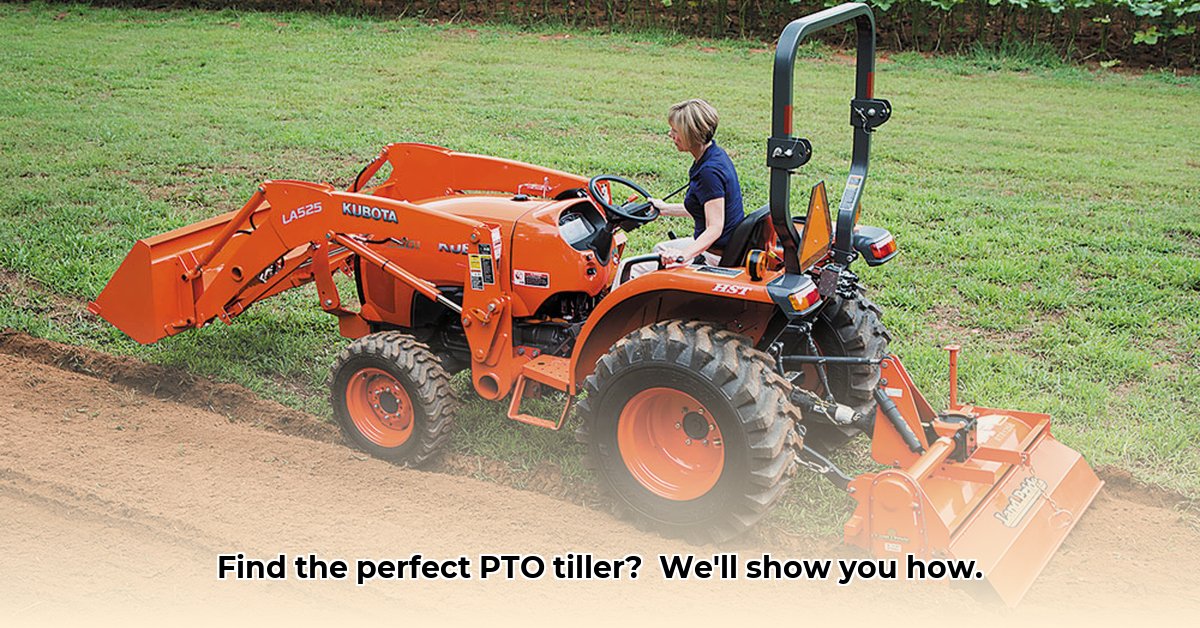
Choosing the right PTO (Power Take-Off) tiller is a crucial investment for any farm. This comprehensive guide will help you navigate the selection process, ensuring you choose a tiller that optimizes efficiency, durability, and sustainability. Whether you're a seasoned farmer or just starting out, this guide provides the knowledge you need to make an informed decision. For more information on specific models, check out this John Deere Tiller Guide.
Key Factors to Consider When Choosing a PTO Tiller
Several key factors influence the selection of a PTO tiller. Careful consideration of these aspects will ensure a long-lasting and effective investment.
Tiller Size and Width: Matching Tractor and Field
The tiller's working width must be compatible with your tractor's horsepower and the size of your fields. A tiller too small will be inefficient, while one that's too large might overload your tractor. Consider your tractor's horsepower rating and the tiller's recommended horsepower range for optimal performance and matching the implement to the size of your fields. Do you have large, open fields or smaller, more confined areas to till? This will significantly influence your size selection.
Tine Type and Durability: Soil Type Considerations
The tines (the rotating blades) are crucial. Different tine materials and configurations suit various soil types. Heavy-duty, hardened steel tines excel in tough, rocky, or clay soils, while lighter tines are more suited for lighter, sandier soils. What type of soil do you primarily work with? Matching the tine type to your soil ensures efficient tilling and minimizes wear and tear on the tiller.
Gearbox and Drive System: The Powertrain's Importance
The gearbox is the tiller's powertrain. A robust gearbox, such as those made of cast iron with an oil bath lubrication system, ensures smooth operation and longevity. Gear-driven systems generally offer greater durability compared to chain-driven systems, especially under heavy use. Consider the type of gearbox and drive system for their reliability and longevity. A durable gearbox is an investment in minimizing costly breakdowns.
Adjustable Skid Controls: Maintaining Consistent Tilling Depth
Adjustable skid controls allow you to maintain a consistent tilling depth, crucial for uniform seedbed preparation and efficient crop growth. Uneven tilling depth can lead to patchy crop growth, reducing yields. This is a subtle but impactful aspect influencing consistent seeding and therefore, crop yield.
PTO Shaft Compatibility: Preventing Damage and Ensuring Safety
Always verify PTO shaft compatibility with your tractor. Using an incompatible shaft is dangerous and can damage both machines. Check the shaft size, speed, and safety features to ensure a safe and effective connection. This seemingly minor detail can result in costly repairs.
Maintenance and Spare Parts: Accessibility and Cost
Consider the availability and cost of spare parts before buying. Easy access to parts reduces downtime and minimizes repair expenses. Prioritize models with readily available, moderately priced replacement components to keep your tiller running smoothly. Proactive maintenance is key to prolonging the tiller's lifespan. How readily accessible are replacement parts in your area?
Sustainable Considerations: Minimizing Environmental Impact
Sustainable farming practices are increasingly important. Choose a tiller that minimizes soil compaction, improves fuel efficiency, and reduces environmental impact. Look for features that minimize the tiller's impact on the environment, such as those that reduce soil disturbance and fuel consumption.
How to Choose a PTO Tiller: A Step-by-Step Guide
This structured approach helps you make an informed decision.
Step 1: Assess Your Needs: What's your soil type? How many acres do you need to till? What's your tractor's horsepower? What is your budget?
Step 2: Set a Realistic Budget: Factor in maintenance, repair costs, and the tiller's lifespan.
Step 3: Research: Explore different brands and models, paying close attention to features and specifications.
Step 4: Seek Input: Talk to other farmers and consult online resources.
Step 5: Check Parts Availability: Contact local dealers to ensure parts are readily available.
Step 6: Make Your Decision: Weigh your needs, budget, and research findings to choose the best tiller for your farm.
Types of PTO Tillers
While specific details may vary greatly between manufacturers, the core categories remain largely consistent.
- Rear-Mount: Simple operation, widely available, but can be less maneuverable.
- Front-Mount: Enhanced maneuverability and better visibility, but potentially higher cost and less common.
- Offset-Mount: Versatile, ideal for hillside or uneven terrain, but more complex to operate.
Maintenance and Troubleshooting
Regular maintenance is essential for prolonging your tiller's lifespan and preventing costly repairs. Regularly check the gearbox oil, inspect tines for wear, and keep the PTO shaft lubricated. Addressing minor issues promptly can prevent major problems.
Conclusion: Choosing the Right Tiller for Your Farm
Investing in the right PTO tiller is a significant decision. By carefully evaluating your needs, considering the factors discussed above, and following the step-by-step guide, you can confidently choose a tiller that optimizes efficiency, sustainability, and longevity for your farm. Remember to prioritize durability, accessibility of parts, and sustainability to maximize your return on investment.